|
 On a few pages short examples of music will start playing automatically
after the download is ready, but only if Microsoft Internet Explorer
is your browser. Mozilla Firefox, Safari and Google Chrome do not have
the facility to let you hear sound in the background.
On a few pages short examples of music will start playing automatically
after the download is ready, but only if Microsoft Internet Explorer
is your browser. Mozilla Firefox, Safari and Google Chrome do not have
the facility to let you hear sound in the background.

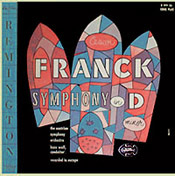
The
second cover made by Curt John Witt for the recording by Hans Wolf of
Symphony in D (César Franck).

See
also:
The
Seattle Times
Andante Magazine

|
Hans
Wolf was a friend of  Marcel Prawy and, like Prawy and so many
other refugees, enlisted in the US Army during World War II. He became
a US citizen and was sent to Europe with the Allied Forces in the
spring of 1945. Via Innsbruck - where he put in a good word for conductor
Marcel Prawy and, like Prawy and so many
other refugees, enlisted in the US Army during World War II. He became
a US citizen and was sent to Europe with the Allied Forces in the
spring of 1945. Via Innsbruck - where he put in a good word for conductor
 Fritz Weidlich
and conducted Tchaikovsky's Fifth Symphony - he returned to Vienna.
But he did not stay very long.
Fritz Weidlich
and conducted Tchaikovsky's Fifth Symphony - he returned to Vienna.
But he did not stay very long.
He
finally choose to settle in the US, but only after making a few recordings
for Don Gabor's Remington Records, starting in 1950 and - according
to the data given by the Austrian web site that lists many historic
data of recordings made in Vienna - he made his last Remington recording
in February 1952 while conducting the Austrian Symphony Orchestra.
Despite
the low quality of the recordings and pressings, and despite the few
recordings that were made of this conductor, one can hear that Hans
Wolf was a man who knew about styles and had insight in whatever score
he would bring to his audience. A Symphony of Wolfgang Amadeus
Mozart is playful and detailed, yet serious.
In
the build up and development of themes in César Franck's
Symphony in D, he creates suspense and excitement, while the individual
structure of every movement comes to light, specifically in the slow,
lyrical movement and passages. His Franck is not the heavy, slow and
ponderous Franck, but a somewhat faster, no less interesting rendering.
In the second movement the orchestra is singing. The performance must
have been the result of good communication and good instruction, no
doubt, but they also convey that the basis of it is talent. Timing
and phrasing are excellent. Dr. Wolf masters the score and is in full
control throughout. The recording greatly evokes his passion for music.
The performance has nuance and never fails to get the attention of
the listener.
|
|
|
Johannes
Brahms: Symphony No. 2 in D Major Op. 75 with the Austrian Symphony
Orchestra conducted by Hans Wolf - Remington R-199-19.
|
Also
his Brahms 2nd has the great line, the structural concept,
asking the utmost discipline of the orchestra, even though the recording
time was limited and he had to rely on the fact that the musicians
knew this or that work already more or less by heart. And his Beethoven's
5th Symphony is assertive and dynamic.
Hans
Wolf was a creative musician, enjoying all sorts of music. He had
imagination. His enthusiasm must have been aroused very easily. "Let's
do it" could have been his life's motto. But he also had the
energy to work, to further the quality and to persevere in following
his ideas, sticking to them, and not being distracted at all.
Wolf's
artistic insight, his feeling for the essence of the music, must have
been a natural gift, but was certainly heightened and shaped when
studying with legendary Heinrich Schenker.
Heinrich Schenker (June 19, 1868 - January
14, 1935) was a musicologist, a composer, and a musician.
He composed mainly for piano, wrote Songs (Lieder), and made
arrangements of Cantatas of Johann Sebastian Bach, of Piano
Concertos of Carl Philip Emanuel Bach, and of Five Organ Concertos
of Handel. He also wrote an "explanation" to Beethoven's
Sonatas Op. 101, 109, 110 and 111. Searching
for the essence of a composition, he analyzed the music and
discovered unexpected complexities and structures existing
within a composition, presenting themselves in layers, showing
the relationships between melody lines and chords. He said
that a composition could be understood in its essence by defining
the "Urlinie", the kernel line, so to speak, and
the "Ursatz", the inner, basic structure which is
the fundament of a composition.
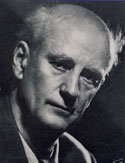 Although
it is stated that Wilhelm Furtwängler never became
a student of Heinrich Schenker, the famous conductor met with
Schenker in person and received ample advice. Heinrich
Schenker had studied with Anton Bruckner and had witnessed
Brahms and Wagner. He also witnessed Mahler and important
composers of the first half of the 20th century like Richard
Strauss and Arnold Schönberg. Wilhelm Furtwängler
had been struck by the ideas Schenker put forward in his book
"Beethovens Neunte Sinfonie" (Beethoven's Ninth
Symphony). Furtwängler writes in his essay on Heinrich
Schenker ("Ton und Wort", 1954, page 198-204), that
he, quite by accident, picked up Schenker's book in 1911,
the time when he started his career in Lübeck where he
was "Kapellmeister". Although
it is stated that Wilhelm Furtwängler never became
a student of Heinrich Schenker, the famous conductor met with
Schenker in person and received ample advice. Heinrich
Schenker had studied with Anton Bruckner and had witnessed
Brahms and Wagner. He also witnessed Mahler and important
composers of the first half of the 20th century like Richard
Strauss and Arnold Schönberg. Wilhelm Furtwängler
had been struck by the ideas Schenker put forward in his book
"Beethovens Neunte Sinfonie" (Beethoven's Ninth
Symphony). Furtwängler writes in his essay on Heinrich
Schenker ("Ton und Wort", 1954, page 198-204), that
he, quite by accident, picked up Schenker's book in 1911,
the time when he started his career in Lübeck where he
was "Kapellmeister".
Furtwangler
did not agree with everything Schenker wrote and he also found
that Schenker could not hold on to his theory of the "Urlinie"
completely and in all instances. Of greater importance however
is the idea introduced by Schenker called "Fernhören"
(Fernhoeren), listening over a distance in time, a philosophical-psychological,
natural, inborn attitude of man. It means understanding the
greater concept of the music, the structure of a musical work,
which goes beyond the annotation, goes beyond a single phrase
or a separate movement. "Fernhören" is hearing
in perspective, hearing the work's evolution, while being
reminded of origin and cause, remembering response and result,
which may well lay in an earlier movement or melody. It is
the ability of the human being that he can listen in time
and space (realm) and thus can grasp the greater architecture
of the music, knowing its origin and its musical key, and
knowing where it leads to. Heinrich Schenker found that "Fernhören",
is most significant in European and specifically in relation
to German classical music.
(Interpreting this idea of Schenker's to the extreme, one
could say that in its essence it is Carl Gustav Jung's "collective
unconscious" made conscious, and finally materializing
in sound.)
As is so often the case when a great mind is devising a theory,
all and everything has to be explained in relation to the
original idea put forward. Nevertheless the Schenkerian
ideas about structure and counterpoint can intensify the
study of music and make the performance of a composition more
comprehensible. In that lies the importance of his approach.
Another writing of Schenker's was on Schubert's 8th Symphony,
Unfinished (Unvollendete), the Symphony that asks for a thorough
understanding of its structure and development, in order to
set the right pace and create the appropriate atmosphere,
right from the first chords of its somewhat mysterious beginning.
Schenker's publications are many.
Understanding
music in this perspective gives birth to a completely new
and greater concept of music in general and of a musical work
in particular.
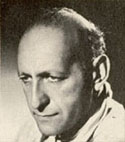 Carl
Bamberger
(1902-1987) was also a student of Schenker's. He started off
as a cellist and became a conductor with a great sense for
timing, and he had full control over the execution when conducting
many a composition. Carl Bamberger migrated to the USA and
became Director of the Orchestra and Opera Section of Mannes
College of Music/School of Music, New York, in 1938 at age
36. You can hear Carl Bamberger on Carl
Bamberger
(1902-1987) was also a student of Schenker's. He started off
as a cellist and became a conductor with a great sense for
timing, and he had full control over the execution when conducting
many a composition. Carl Bamberger migrated to the USA and
became Director of the Orchestra and Opera Section of Mannes
College of Music/School of Music, New York, in 1938 at age
36. You can hear Carl Bamberger on  Concert
Hall Society - Musical Masterpiece Society recordings.
Concert
Hall Society - Musical Masterpiece Society recordings.
A
senior student of Schenker's was Anthony van Hoboken
(1887-1983) from the Netherlands, who at age 22 left Rotterdam
and went to live in Frankfurt (Germany) to study harmony and
composition and eventually came to Vienna to study with Schenker.
 In
1927 he began his 'Archiv für Photogramme musikalischer
Meister-Handschriften' (Archive of photograms of musical
master manuscripts). He researched the collections of museums
and libraries and collected privately also the manuscripts
of the great European composers. During World War II the collections
were stored in fireproof vaults and survived. Hoboken gave
the world the 'Hoboken Verzeichnis' which systematically
catalogues the works of Josef Haydn. He had started working
on it since 1934 and it was ready in 1957. (Image taken from
Dutch music monthly Mens en Melodie, issue no. 4, 1957.) In
1927 he began his 'Archiv für Photogramme musikalischer
Meister-Handschriften' (Archive of photograms of musical
master manuscripts). He researched the collections of museums
and libraries and collected privately also the manuscripts
of the great European composers. During World War II the collections
were stored in fireproof vaults and survived. Hoboken gave
the world the 'Hoboken Verzeichnis' which systematically
catalogues the works of Josef Haydn. He had started working
on it since 1934 and it was ready in 1957. (Image taken from
Dutch music monthly Mens en Melodie, issue no. 4, 1957.)
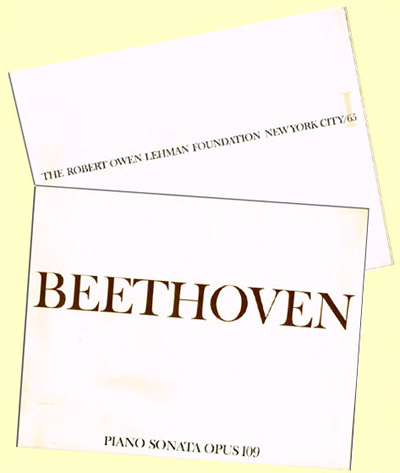
Schenker
had many more pupils and followers. Another important name
is that of Oswald Jonas who maintained correspondence
with Heinrich Schenker from 1908 until Schenker's death. To
students and collectors Jonas is generally known for his introduction
to the facsimile of Beethoven's Sonata Op. 109 (also with
the annotation "für das Hammerklavier"). The
Robert Owen Lehman Foundation had the facsimile printed
by Van Leer Printers in the Netherlands though without the
original title page. The Library of Congress, Washington
D.C., made the manuscript avaible.
Other
names of Schenker students are those of composer Paul Hindemith,
conductor Otto Klemperer, composer Arnold Schönberg
and ... Hans Wolf who had met these important figures
and had absorbed the deeper meaning of Schenker's work, theory
and insight.
- Rudolf A. Bruil
|
Hans
Wolf at 21 must have been about the youngest student of Heinrich Schenker's.
Wolf studied for nearly two years with Heinrich Schenker, from March
1933 till the end of 1934; Schenker died in January 1935.
In
the correspondence between Heinrich Schenker and his pupil Oswald
Jonas, there is a letter describing a nasty occurrence in September
of 1934. After having traveled from Vienna to Hamburg, young Hans
Wolf, who was Jewish, was denied by the Nazis to return to Vienna.
Through the intervention of Wilhelm Furtwangler however, he
was allowed to return. Such an experience and witnessing other incidents
most certainly made him decide to return to the US in the early 1950s.
CHOOSE
ANOTHER SUBJECT
|
|
|
Hans
Wolf in the nineteen eighties.
Picture courtesy the Seattle
Opera.
|
Hans
Wolf was originally from Hamburg, he was born in the Hansa town on
December 5, 1912, came to Vienna to study at the University and received
a Ph.D. in 1937. The title of his thesis was "Notions of Musical
Movement in the Teachings of Bass and Composition of the 18th Century
as a Continuation of the Instruction of the Counterpoint" (Die
musikalischen Bewegungsbegriffe in den Generalbaß- und Kompositionslehren
des 18. Jahrhunderts als Fortsetzung der Lehre vom Kontrapunkt”).
The subject of his thesis shows the influence of Heinrich Schenker.
The
political situation in Austria was getting more and more threatening.
The earlier Hamburg incident, the rumors that the Anschluss
(Annexation) could be at hand, and the fact that Hans had now finished
his studies and had received his title, these made the Wolf family
(Hans Wolf was now 26 years of age) decide to migrate to the United
States where they found refuge, as so many Europeans who fled for
the Nazis did.
|
|
|
The
early release of Cesar Franck's Symphony in D conducted by Hans
Wolf - Remington RLP-199-36 recorded on 11 July, 1950.
|
|
|
Click
for a Sound Clip of a fragment of Franck's Symphony in D
Second movement.
|
|
|
In
the US, Wolf taught at John Fletcher College (Iowa) for a while.
He enlisted in the Army, probably in 1943, the same year as Marcel
Prawy did. Wolf became a translator and was sent to Europe. In 1945
he returned to Vienna, to the musical culture that formed him.
Like
Berlin also Vienna was divided into sectors by the four powers: the
US, the UK, France and the Soviet Union. Although Wolf later said
that he was living it up, he must have experienced the cumbersome
and restricted atmosphere. He was aware of the fact that most Austrians
just continued where they had left off in 1938 and held their conservative
beliefs. He would not stay very long. After he had made recordings
for Remington as a conductor - and had assisted producer Marcel Prawy
at several instances and was involved with the special Masterseal
series of high priced LP recordings - he returned to the New World.
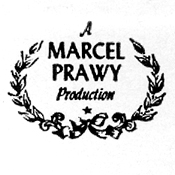 The
Masterseal discs were pressed on a higher quality vinyl and were presented
in luxurious, heavy gatefold covers of which the liner notes were
adorned with the laurel emblem mentioning "A Marcel Prawy Production". The
Masterseal discs were pressed on a higher quality vinyl and were presented
in luxurious, heavy gatefold covers of which the liner notes were
adorned with the laurel emblem mentioning "A Marcel Prawy Production".
|
|
From
left to right: Dr. Hans Wolf - Dr. Marcel Prawy -
Prof. Fritz Busch - Dr. Hans Sachs, and possibly a recording technician
or janitor in 1950.
Image courtesy KHM-Museumsverband, Vienna.
Copyright http://www.theatermuseum.at/
|
Hans Wolf left for the US in 1952. For about one year he was involved
in the early stereo recordings of Audiosphere Binaural tapes. See
the elaborate page published by  Bob Furmanek
about the history of stereo recordings on tape and disk in the 1950s
and the page about
Bob Furmanek
about the history of stereo recordings on tape and disk in the 1950s
and the page about  Raymond
Cook.
Raymond
Cook.
There
are a few instances when Hans Wolf returned to Europe on a visit.
That was in early 1953, as Marcel Prawy recounted in his book "Marcel
Prawy talks about his life" (Marcel Prawy erzählt aus seinem
Leben, Kremayr & Scheriau, Vienna, 2001). And Wolf traveled to
Germany in 1958 and/or 1959 and conducted the Mannheim National
Symphony Orchestra in a recording of a Haydn Symphony which was
released in the US on the Period label.
|
|
|
|
Hans
Wolf in the nineteen seventies. Images submitted by Monte Jacobson,
courtesy The Seattle Opera.
Picture courtesy the Seattle Opera.
|
Hans
Wolf at 90, conducting Johann Strauss's Operetta The Gypsy Baron
in Seattle in 2003.
Picture courtesy the Seattle Opera.
|
As
said, when Marcel Prawy started producing and taping performances
for Donald Gabor's Remington Records in 1950, he also asked Dr. Hans
Wolf, still living in Vienna, to join him. Wolf made recordings of
compositions by Beethoven, Brahms, Franck, Mozart, and by Haydn (with
cellist Gaspar Cassadó).
Below
two examples of Masterseal LP recordings. It is not sure whether Hans
Wolf was involved with these or other recordings.
|
|
|
|
A
unique recording of Volkmar Andreae at 70 years of age:
Bruckner's Symphony No. 1 on Masterseal MW-40, released in the
Fall of 1951
|
Vittorio
Gui conducts Mendelssohn Bartholdy's 'Reformation Symphony'
(No. 5) and Hebrides Overture. MW-49, released in August of 1952
|
After
Wolf had returned to America he worked in various cities and with
several opera companies. For Four Star Television in Los Angeles he
conducted Aida (Verdi) and Carmen (Bizet). At the invitation of Glynn
Ross (founding General Director of the Seattle Opera) and conductor
Henry Holt, Wolf became assistant and then associate conductor
and chorus master of the Seattle Opera from 1969 till 1981. He performed
many operas in English, often with his own translation, Associated
Press reported. From 1981 until 1996 he led the revival of  Tacoma Opera,
serving as artistic director and conductor.
Tacoma Opera,
serving as artistic director and conductor.
In
2003 Hans Wolf was honored by Seattle's Mayor Greg Nickels
by proclaiming March 30, 2003, Hans Wolf Day. He also received congratulations
from Washington's governor and a special handwritten note from Beverly
Sills on "MET" stationery. On August 5, 2005, Hans Wolf
died in Seattle.
CHOOSE
ANOTHER SUBJECT
 |
|
|
Violoncellist
Gaspar Cassado plays Haydn's Cello Concerto with the Austrian
Symphony Orchestra, Hans Wolf conducting.
Mozart's K 385, Haffner, was also released in France on a 10"
Concerteum: TCR 257.
|
|
|
|
Beethoven's
Symphony No. 5 conducted by Hans Wolf was one of the earliest
Remington releases. Above is the modern cardboard cover with
the Remington logo designed by Alex Steinweiss.
At left César Franck's Symphony in D on the German DIAMANT
label.
|
|
The
pre-Steinweiss cover of the recording of Hans Wolf conducting
Symphony No. 2 of Johannes Brahms on RLP-199-19.Cover by Sherman
Alpert.
|
|
|
The
recording of Symphony in D of Cesar Franck was also available
on the Plymouth-Merit label (P-12-4), omitting the name of the
conductor.
|
|
The
recordings of Hans Wolf for Remington Records:
R-149-9
- Beethoven: Symphony No. 5. The Austrian Symphony Orchestra.
(Also released as Plymouth P-12-65.) (Released in the Spring of 1951).
In a discography "Ludwig van Beethoven on records" in High
Fidelity Magazine (Spring, 1952) music critic C.G. Burke wrote about
Hans Wolf's recording of the Fifth Symphony. Wolf's competitors were
Otto Klemperer, Willem Mengelberg, Bruno Walter, Carl Schuricht, and
Serge Koussevitzky.
C.G.
Burke made a comprehensive study of the recordings of works
by Beethoven which was published in High Fidelity Magazine,
Spring 1952 edition. He explained how the study was made.
"There are 230 recorded versions of 119 Beethoven works, occupying
329 sides (...) this compendium reviews every Beethoven work
recorded on LP as of mid-January. (...) Since the synopsis was
conceived as a practical guide for music lovers, the writer
has submerged his own prejudices as rigidly as he could. He
has tried to indicate the broader, the more universal values
of the discs, rather than certain niceties or certan eccentricities
pleasing or repellent to himself."
About
Beethoven's Fifth conducted by Hans Wolf, Burke wrote:
"The
Wolf direction is the most direct of all. This Symphony, with
all its magnificence has a very simple plan to which the conductor
adheres without deviation. This is the way qualified conductors
conduct untill an overwhelming consciousness of their own réclame
inspires them to make improvements in masterpieces. Wolf's would
be the best edition if his orchestra had been closer to unanimity
and the recording, which is solidly satisfactory, more luminous
in differentiation." - C.G. Burke - High Fidelity, Spring
1953
|
 From
the
From
the  Kurt Wöss Page: On Masterseal MSLP
5008 Beethoven's Symphony No. 5 and Schubert's Symphony No. 8 conducted
by Kurt Wöss can be found, whereas there exists no Remington
disc with this coupling conducted by Wöss. Originally Beethoven's
Fifth was released on a 10" disc (R-149-9) with the Vienna Symphonic
Society Orchestra conducted by Hans Wolf and Schubert's Eighth was
originally a recording with conductor H. Arthur Brown (R-149-15).
The name Wöss was probably a convenient substitute, especially
when Brown had fallen from grace and the Remington label had ceased
to exist.
Kurt Wöss Page: On Masterseal MSLP
5008 Beethoven's Symphony No. 5 and Schubert's Symphony No. 8 conducted
by Kurt Wöss can be found, whereas there exists no Remington
disc with this coupling conducted by Wöss. Originally Beethoven's
Fifth was released on a 10" disc (R-149-9) with the Vienna Symphonic
Society Orchestra conducted by Hans Wolf and Schubert's Eighth was
originally a recording with conductor H. Arthur Brown (R-149-15).
The name Wöss was probably a convenient substitute, especially
when Brown had fallen from grace and the Remington label had ceased
to exist.


The
second cover and label of Remington R-149-33
R-149-33
- Mozart:
Symphony No. 35 "Haffner" (K 385) (Released in the Summer
of 1951)
R-149-48
- Beethoven:
Egmont Overture, conducted by Hans Wolf (coupled with Overture Ruy
Blas, Mendelssohn, conducted by George Singer)
R-199-19
- Brahms: Symphony No. 2 in D Major Op. 73 (Released in the Fall
of 1951)
R-199-36
- Franck: Symphony in D minor (Released in the Fall of 1951)
R-199-79
- Haydn: Cello Concerto with Gaspar Cassado and Mozart Symphony
no. 35 "Haffner" (K 385) (Released in May 1951)
 Hans Wolf conducted
the Niederöstereichisches Tonkünstler Orchester at various
occasions. On January 28, 1951, he led the orchestra in Wolfgang Amadeus
Mozart (Symphony K 385, „Haffner“), Anton Dermota singing
the aria of Don Ottavio from „Don Giovanni” (K 527), and
two songs by Richard Strauss (Morgen, Op. 27, No.4, and Ständchen,
Op. 17, No 2), and the program concluded with Outdoor Overture by
Aaron Copland performed at the occasion of the 50th aniversary of
the composer.
Hans Wolf conducted
the Niederöstereichisches Tonkünstler Orchester at various
occasions. On January 28, 1951, he led the orchestra in Wolfgang Amadeus
Mozart (Symphony K 385, „Haffner“), Anton Dermota singing
the aria of Don Ottavio from „Don Giovanni” (K 527), and
two songs by Richard Strauss (Morgen, Op. 27, No.4, and Ständchen,
Op. 17, No 2), and the program concluded with Outdoor Overture by
Aaron Copland performed at the occasion of the 50th aniversary of
the composer.
On January 20, 1952, he conducted Franz Schubert (Symphony no. 1),
César Franck (Variations symphoniques with pianist Grete Scherzer),
and Peter Tchaikovsky (Pathétique Symphony).
The dates of these live performances are not
the dates the recording sessions took place.
The
last recording Wolf made for the Remington label was taped on Wednesday,
February 13, 1952 starting at 2 pm at the Musikverein in Vienna. He
conducted the Niederösterreichisches Tonkünstlerorchester
in Cello Concerto by Joseph Haydn, Gaspar Cassado being the soloist.
Producer was Marcel Prawy.
Soon after that Wolf must have left Vienna.
 As
he had become an American citizen, he easily could leave without delay. As
he had become an American citizen, he easily could leave without delay.
In
1953 Wolf returned for a short while to be involved with the first
stereo recordings of conductor Vittorio Gui taped during the Florence
May Festival in Italy. On the program were Finlandia and Valse Triste
(Jean Sibelius), Peer Gynt Suite No. 1 (Edvard Grieg), and Overtures
to Flying Dutchman and Tannhäuser (Richard Wagner). At a later
date Hans Wolf wrote an extensive article about the benefits of stereophonic
tape recording as he had been working with
 Livingstone Audio.
Livingstone Audio.
|
|
|
Hans
Wolf in 1955 when he was Musical Director for Livingston Electronics.
|
One
may regret that Dr. Hans Wolf did not make more recordings for the
Remington label or another label as the performance of the Franck
Symphony in D is very well conducted and has atmosphere, and after
all shows his natural feeling for song, melody and presentation. And
though the performance is absolutely Wolf's, the influence of Heinrich
Schenker is certainly noticeable.
 As
I mentioned earlier, there is only one more recording known to me
of Hans Wolf made for another label and that is the one when he conducted
the Mannheim National Symphony Orchestra in Haydn's Military Symphony
(No. 100, in G). On Side One of that disc is Symphony No. 94 conducted
by Herbert Albert. The recording was issued in 1959 in the Period
Showcase Series. Reference SHO-2321 (stereo) and SHO-321 (mono). As
I mentioned earlier, there is only one more recording known to me
of Hans Wolf made for another label and that is the one when he conducted
the Mannheim National Symphony Orchestra in Haydn's Military Symphony
(No. 100, in G). On Side One of that disc is Symphony No. 94 conducted
by Herbert Albert. The recording was issued in 1959 in the Period
Showcase Series. Reference SHO-2321 (stereo) and SHO-321 (mono).
 The
Period Showcase Series contained recordings which were bought from
European and Russian labels. Violinist David Oistrakh, Pianist Emil
Gilels, and conductors Samuil Samosud, Kiril Kondrashin, and Alexander
Gauk performed with the Bolshoi Theater Orchestra and the USSR State
Orchestra. And there were the Vienna Symphony, The Paris Chamber Orchestra,
The Lucerne Festival Orchestra, The Paris National Orchestra, The
Vienna State Opera Orchestra, and the Manheimer National Symphony
Orchestra.
The
Period Showcase Series contained recordings which were bought from
European and Russian labels. Violinist David Oistrakh, Pianist Emil
Gilels, and conductors Samuil Samosud, Kiril Kondrashin, and Alexander
Gauk performed with the Bolshoi Theater Orchestra and the USSR State
Orchestra. And there were the Vienna Symphony, The Paris Chamber Orchestra,
The Lucerne Festival Orchestra, The Paris National Orchestra, The
Vienna State Opera Orchestra, and the Manheimer National Symphony
Orchestra.
CHOOSE
ANOTHER SUBJECT
Opera
director Lincoln Clark who started as an opera singer in California,
studied with Lotte Lehmann and went to Germany to act in films and
on the stage, and who later became a known director, wrote to me after
seeing the page about Hans Wolf in 2008:
"Hans and
I were colleagues and best friends working for Seattle Opera
over a period of 10 years, positive, dedicated, superb musician,
generous to a fault, and a charming fellow. Seattle misses him."
- Lincoln Clark, opera director.
 Lincoln
Clark, 1926-2016
Lincoln
Clark, 1926-2016
|
Melinda Bargreen, Seattle Times music critic, mentions in  Hans
Wolf's Obituary (Monday, August 8, 2005) how Hans Wolf, late in
his life was invited back to Germany.
Hans
Wolf's Obituary (Monday, August 8, 2005) how Hans Wolf, late in
his life was invited back to Germany.
"One
of his proudest moments was his trip in 1991 to the town of
Linz-on-Rhine, near Cologne, Germany, for a ceremony erecting
a plaque to Jewish victims of World War II. The town dedicated
a public square to Dr. Wolf's uncle, surgeon and humanitarian
Dr. Sigmund Wolf, an immigrant to this country who died in
1952.
When Hans Wolf arrived in Linz, researchers handed him a meticulous
12-page transcript of the trial of those who had ransacked
his uncle's family home in the infamous Kristallnacht, the
night of broken glass, when Nazis ran through the streets
of Germany smashing windows and destroying property belonging
to Jews.
"A part of Germany has gone kaput," Hans Wolf recalls
his uncle saying. "It's time for us to go." (Hans
Wolf's family in Hamburg, warned that they were on the death
lists, had already left for the U.S.)
Linz-on-Rhine named the square "Sigmund-Wolf-Platz."
At the dedication ceremony, Hans Wolf took a quotation from
Beethoven's Ninth Symphony as the text for his speech: "Alle
Menschen werden Brüder." ("All men become brothers.")
It was an apt text for Dr. Wolf's own life, as he constantly
extended the hand of friendship to aspiring musicians and
audiences." - Melinda Bargreen
|
Original research,
concept and text (c) Rudolf A. Bruil. Page first published March 25,
2008
|